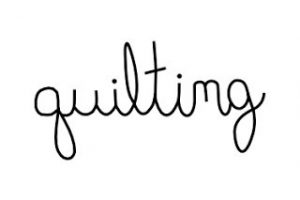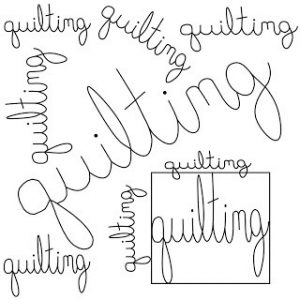

Memorizing Quilting Designs
September 15, 2020
Hi!
This article below was from our regular magazine contributor Leah Day – a wonderfully talented quilter, with a knack for common-sense quilting how to’s. Check out her insights below into memorizing quilting designs…
“This month let’s talk about memorizing designs.
This is super important because the truth is there’s no All Inclusive Master Way to fill a quilt with any filler design. There isn’t some magic bullet or golden rule. You just stitch the design on the quilt and make it fit into the space you want it to go.
There are certainly methods to make it easier which we’ll be exploring a lot this year, but there’s no ONE way.
And often the hardest thing about beginning is knowing where to begin, how to move, and how to keep the design flowing across your quilt in a steady way.
So how do you know what to stitch next in a design? How are quilters able to “see” and plan for what to quilt next?
To explain this we need to talk about something slightly unrelated to quilting: Letters!
The fact is, all free motion designs are quilted exactly the same way you write your name.
I’m not saying you’re going to literally write “Debra” “Barbara” or “Sally”, though if you wanted to that would be a really interesting way to quilt a quilt.
What I mean instead is each design can be memorized the same way you’ve memorized how to write letters.
Take a look at this image:

This is “quilting” written in cursive. Way back in 3rd grade I learned how to write each letter and connect them together. Each letter is created by forming that specific shape, but it’s also governed by a simple set of RULES as well.
For example, the letter Q has a rule that you start with an O shape, then swirl around and down with a little loopy tail, then branch out for the next letter.
If you started with a L shape, that wouldn’t work. The letter wouldn’t look right and no one would be able to recognize that it was the letter Q.
So there’s a basic set of RULES behind each letter of the alphabet.
No matter which alphabet you’re using, you always have to make your letters fit roughly a similar size and shape, otherwise no one will be able to recognize and read what you’re writing.
Those that deviate too far have sloppy handwriting. They don’t follow the rules closely enough for their letters easily recognizable, much to the frustration of everyone else!
But there’s a further lesson with letters – how they connect is also governed by more rules!
How the Q connects with the letter U has a specific rule. You can’t just wiggle off randomly, you have to connect the letters in a specific way, again because if you deviate too far, no one will be able to understand what you’re writing.
So what do all these rules have to do with free motion quilting?
The point I’m trying to make here is simple:
- Letters are governed by lots of simple rules.
- You learned these rules a long time ago and memorized them.
- Once memorized, you can write those letters anywhere without THINKING too hard about it.
Take a minute to write the word “quilting” down on a piece of paper. Did you need to stop and think for a minute about how the letters L, T, and I are formed or connect together?
Nope. You just wrote the word, right?

You just WROTE IT. You didn’t stop to think about it. You didn’t have to pause and make sure the Q was facing in the right direction, you didn’t have to question how much space to put between each letter. You just wrote it.
Now write “quilting” BIG.
Now write “quilting” small.
What changes? How do you know how to write it big? How do you know how to write it small?
All the rules stay the same, but somehow you’re able to expand each line, draw out and extend each letter so the word becomes big. Similarly you’re able to shrink each letter down and fit it into a tiny space too.
Did you have to think about the word any more writing it big or small?
No. You just wrote it!
If you can do this with letters and writing, you can do this the EXACT SAME WAY with free motion quilting!
Right now if you’re just starting out, you don’t have any designs memorized. You’re basically back in 3rd grade just learning how to form the letters A, B, and C in cursive.
Do you remember what you did to learn those letters the first time?
You practiced drawing the same letter over and over and over again. You practiced in rows, within big lines on paper.

You practiced until your little hand hurt. You practiced each letter for 1 week until you had all the letters of your alphabet down, and while learning how to form them, you were also learning how to put them together.
And you can learn ANY free motion design the same way!
Each week we’re going to focus on a design and I’m going to break the RULES of the design down with simple steps for you to practice, exactly like you practiced writing the letter “A” first in 3rd grade.
Get a notebook with wide lines and keep it at your kitchen table to practice drawing designs.
The more you draw and make those movements with a pencil, the more your brain will remember those shapes and angles when you’re quilting a real quilt.
And please don’t tell me you can’t draw and therefore can’t practice this way. This isn’t drawing, it’s WRITING!
If you can sign your name, you can write a free motion design and practice it on paper.
Remember – letters and free motion designs really are just wiggly lines. They just happen to be special wiggles governed by rules that make them readable or make them fit into xyz design.
The trick is getting to the point where you don’t think about forming the design anymore.
You don’t have to stop and consider “should I wiggle twice here or should I go down and back up?” You just stitch it.
When you get to this point you’ll no longer have to worry so much about forming the design, and will be able to focus more on moving your quilt with your hands and controlling the speed of your machine with your foot.
So I hope this makes sense and you’ll spend some time writing “quilting” today to see what I mean.”
Leah Day
About the Author: Leah Day is the author of the Free Motion Quilting Project, a blog project dedicated to creating new free motion quilting designs each week and sharing them all for FREE!
Leah is also the author of From Daisy to Paisley – 50 Beginner Free Motion Quilting Designs, a spiral bound book featuring 50 designs from the project, and she now has three Free Motion Quilting classes available through craftsy.com . www.daystyledesigns.com


Leave a Reply